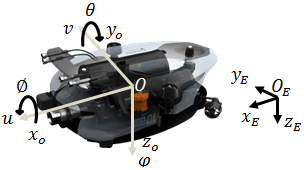The Basic Study of Underwater Robot Control for Over Actuated Systems
Keywords:
over actuated system, ROV, motion control, 6 DOFAbstract
In general, only six individual thrusters are required to perform 6 DOF (Degree Of Freedom) motion. Sometimes, however, more than six thrusters are used for 6 DOF motion for a variety of purposes. The over actuated systems can transit quickly from transient state caused by disturbance to steady state through the over actuated input. So in the underwater robot, the purpose of over actuated system is mainly used to maintain stable motion and position. And that systems are performed to obtain the optimal efficiency through the thruster force distribution. In this paper, we designed and fabrication the ROV (Remotely Operated Vehicle) for the basic study of over actuated underwater robot. It has 4 horizontal thrusters and 4 vertical thrusters. Using this system, we derived the thruster force distribution matrix for thruster allocation. Also, to check the kinetic characteristics of over actuated underwater robot before applying various controller, we performed the basic motion performance test and motion control test using the PD controller in the indoor engineering water basin.
References
B. He, B. R. Wang, T. H. Yan, and Y. Y. Han, “A distributed parallel motion control for the multi-thruster autonomous underwater vehicle,” Mechanics Based Design of Structures and Machines, vol. 41, no. 2, pp. 236-257, February 2013.
R. D. Christ and R. L. Wemli Sr, The ROV manual:a user guide for remotely operated vehicles, 2nd ed. Butterworth-Heinemann, 2013.
T. I. Fossen, T. A. Johansen, and T. Perez, A survey of control allocation methods for underwater vehicles, InTech, pp. 109-128, 2009.
T. I. Fossen, Guidance and control of ocean vechicles, New York: John Wiley & Sons Inc, September 1994.
D. H. Kim, Redundancy resolution and robust controller design for dynamic stability enhancement of underwater vehicle-manipulator systems, Doctorate Thesis, Korea, Graduate School of Department of Mechanical Engineering, 2016.

Published
How to Cite
Issue
Section
License
Copyright (c) 2019 Keon Seok Nam, Dong Gu Lee, Je Doo Ryu, Kyoung Nam Ha

This work is licensed under a Creative Commons Attribution-NonCommercial 4.0 International License.
Submission of a manuscript implies: that the work described has not been published before that it is not under consideration for publication elsewhere; that if and when the manuscript is accepted for publication. Authors can retain copyright of their article with no restrictions. Also, author can post the final, peer-reviewed manuscript version (postprint) to any repository or website.

Since Oct. 01, 2015, PETI will publish new articles with Creative Commons Attribution Non-Commercial License, under The Creative Commons Attribution Non-Commercial 4.0 International (CC BY-NC 4.0) License.
The Creative Commons Attribution Non-Commercial (CC-BY-NC) License permits use, distribution and reproduction in any medium, provided the original work is properly cited and is not used for commercial purposes



